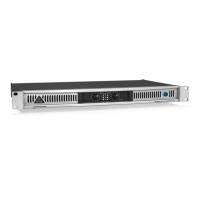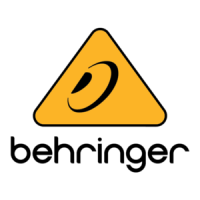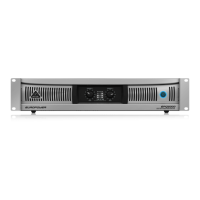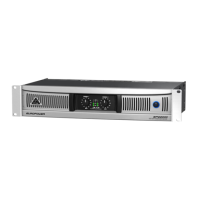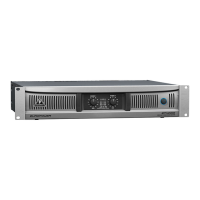Do you have a question about the Behringer EUROPOWER EPQ304 and is the answer not in the manual?
Essential safety guidelines for operating the amplifier, including handling, environment, and electrical safety.
Registering your purchase online and accessing support for efficient service.
Procedure for making warranty claims and returning products for service.
Details specific conditions and components not covered by the limited warranty.
Covers liability limits, statutory rights, and national law applicability to the warranty.
Information on potential changes to warranty terms and conditions.
Illustrates the initial connection process for the amplifier and associated equipment.
Diagram for connecting the amplifier in a DJ configuration.
Example connection for a zone amplifier in a small shop environment.
Diagram for connecting the amplifier for a guitar rig setup.
Explains the front panel controls, indicators, and their functions for operation.
Describes the function of Signal and Limit LEDs for monitoring audio levels.
Instructions on how to adjust input gain levels using the rotary controls.
Details the power button function and rack ear mounting for installation.
Guide to connecting the power cable and using twist-locking speaker outputs.
Details input jack types and how to select amplifier operating modes (Mono, Stereo, Bridge).
Steps for initial setup, including turning off the amplifier and sound source.
Instructions for setting gain controls and adjusting output levels from the sound source.
Guidance on monitoring Limit LEDs and adjusting gain for optimal balance.
Explains the bi-amping concept and its benefits for speaker efficiency and sound clarity.
Provides detailed power output figures for stereo and bridged modes under various conditions.
Lists front and rear panel controls, and describes the status indicators.
Details circuit type, input sensitivity, impedance, output connectors, and distortion.
Information on amplifier protection, load protection, and cooling mechanisms.
Specifies voltage requirements, fuses, power consumption, and physical dimensions/weight.
Details FCC rules compliance for Class B digital devices and potential interference mitigation.
Essential safety guidelines for operating the amplifier, including handling, environment, and electrical safety.
Registering your purchase online and accessing support for efficient service.
Procedure for making warranty claims and returning products for service.
Details specific conditions and components not covered by the limited warranty.
Covers liability limits, statutory rights, and national law applicability to the warranty.
Information on potential changes to warranty terms and conditions.
Illustrates the initial connection process for the amplifier and associated equipment.
Diagram for connecting the amplifier in a DJ configuration.
Example connection for a zone amplifier in a small shop environment.
Diagram for connecting the amplifier for a guitar rig setup.
Explains the front panel controls, indicators, and their functions for operation.
Describes the function of Signal and Limit LEDs for monitoring audio levels.
Instructions on how to adjust input gain levels using the rotary controls.
Details the power button function and rack ear mounting for installation.
Guide to connecting the power cable and using twist-locking speaker outputs.
Details input jack types and how to select amplifier operating modes (Mono, Stereo, Bridge).
Steps for initial setup, including turning off the amplifier and sound source.
Instructions for setting gain controls and adjusting output levels from the sound source.
Guidance on monitoring Limit LEDs and adjusting gain for optimal balance.
Explains the bi-amping concept and its benefits for speaker efficiency and sound clarity.
Provides detailed power output figures for stereo and bridged modes under various conditions.
Lists front and rear panel controls, and describes the status indicators.
Details circuit type, input sensitivity, impedance, output connectors, and distortion.
Information on amplifier protection, load protection, and cooling mechanisms.
Specifies voltage requirements, fuses, power consumption, and physical dimensions/weight.
Details FCC rules compliance for Class B digital devices and potential interference mitigation.
| Damping factor | 80 |
|---|---|
| Amplifier class | D |
| Audio output channels | 4.0 channels |
| Peak power per channel | 75 W |
| Signal-to-Noise Ratio (SNR) | 100 dB |
| Total Harmonic Distortion (THD) | 0.3 % |
| Dynamic power per channel (8 Ohm) | 50 W |
| RMS power output per channel (4 Ohm) | 65 W |
| RMS power output per channel (8 Ohm) | 40 W |
| Bridge-mode power output per channel (8 Ohm) | 130 W |
| XLR in | Yes |
| Speakers connectivity type | XLR / 1/4\ |
| Purpose | Performance/stage |
| Cooling type | Active |
| Product color | Black, Grey |
| Connectivity technology | Wired |
| AC input voltage | 100-240 V |
| Power consumption (typical) | 530 W |
| Depth | 265 mm |
|---|---|
| Width | 482 mm |
| Height | 49 mm |
| Weight | 4700 g |
